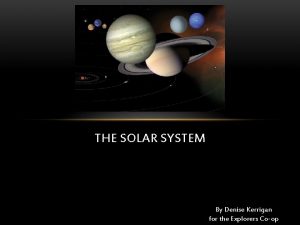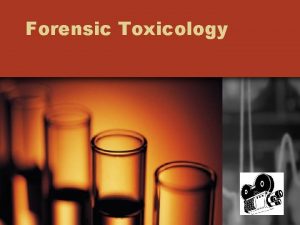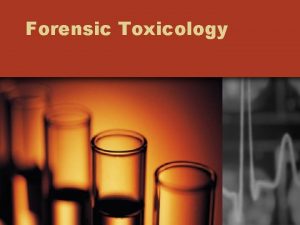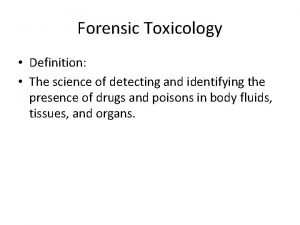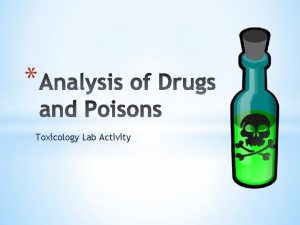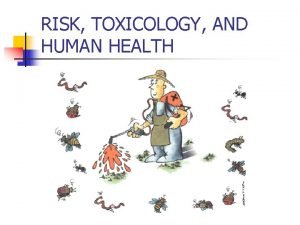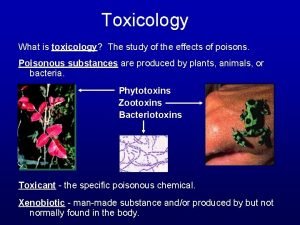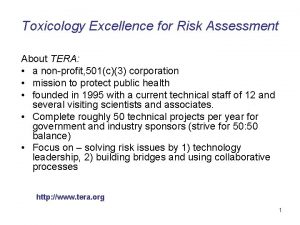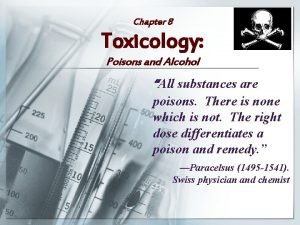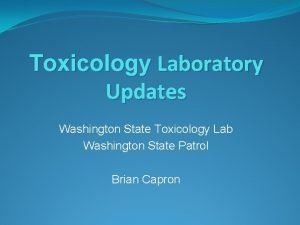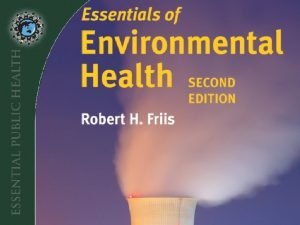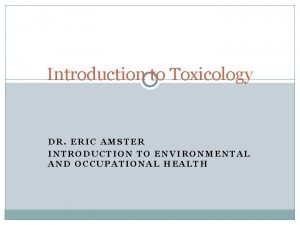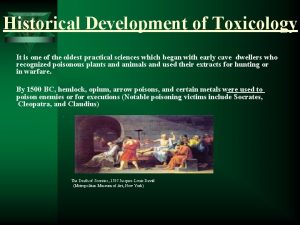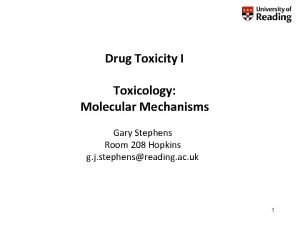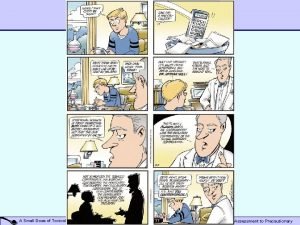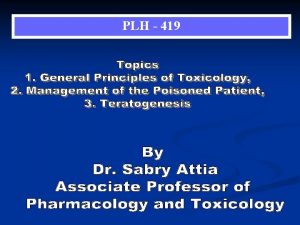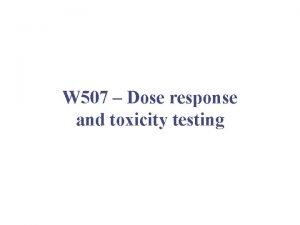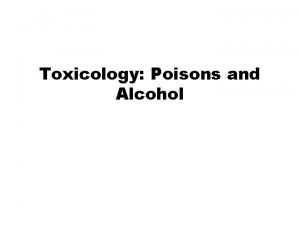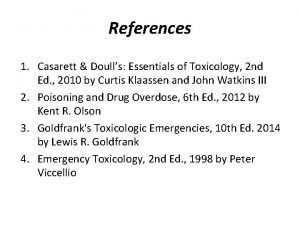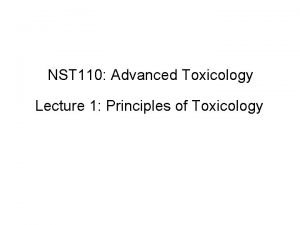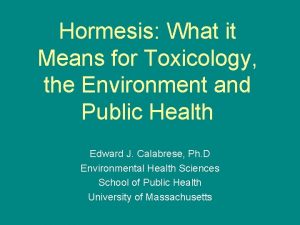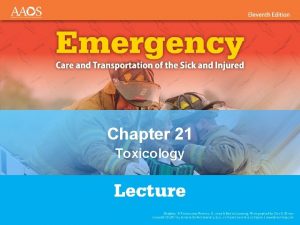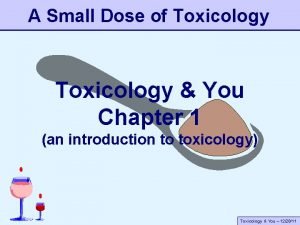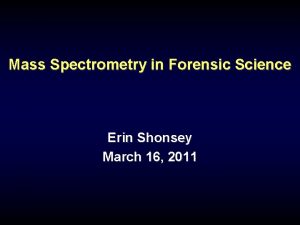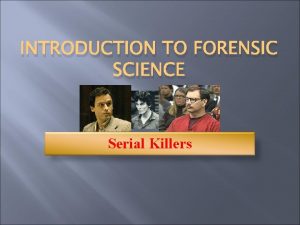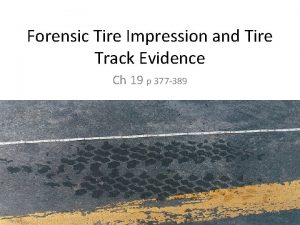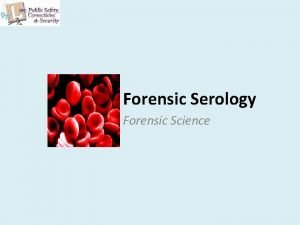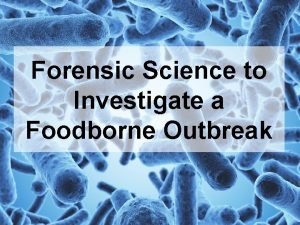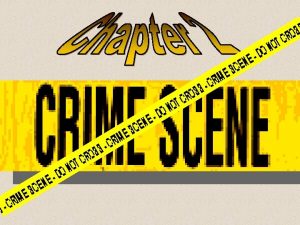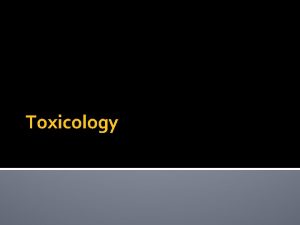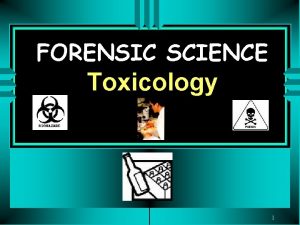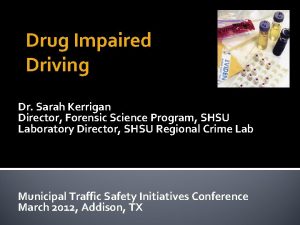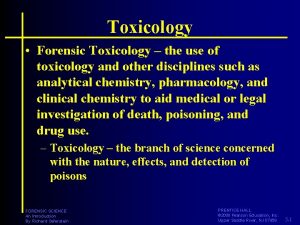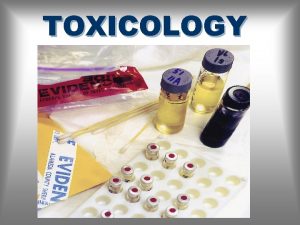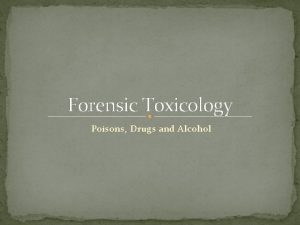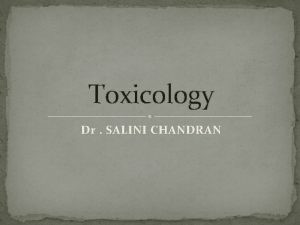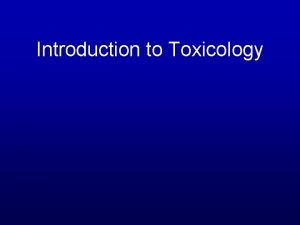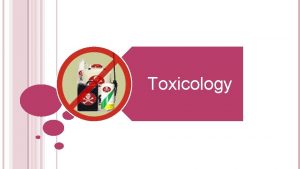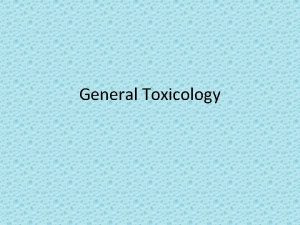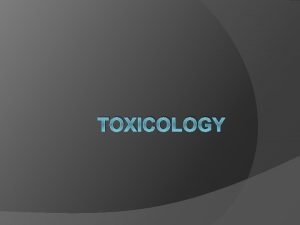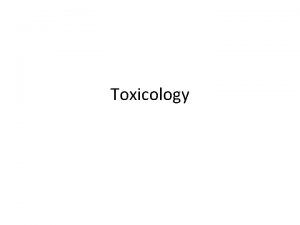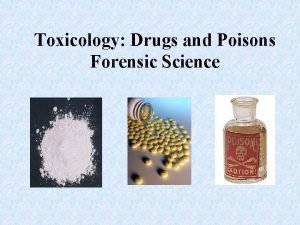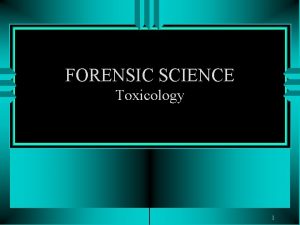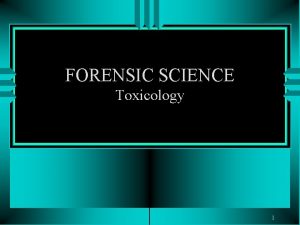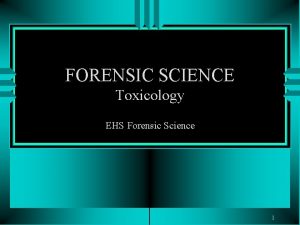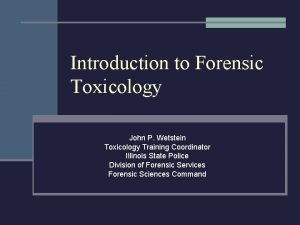Forensic Toxicology Dr Sarah Kerrigan Director Forensic Science






















![Toxicology Challenges and Misconceptions in Impaired Driving What level of [DRUG] is equivalent to Toxicology Challenges and Misconceptions in Impaired Driving What level of [DRUG] is equivalent to](https://slidetodoc.com/presentation_image_h/1145dda156886f17da9e1cfffd8ff0a4/image-23.jpg)
























- Slides: 47

Forensic Toxicology Dr. Sarah Kerrigan Director, Forensic Science Program, SHSU Laboratory Director, SHSU Regional Crime Lab The Texas Criminal Justice Integrity Unit & The Texas Forensic Science Commission Joint Conference on Forensic Science Austin, TX June 4 -5, 2012

Trends and Challenges Analytical challenges Alcohol vs. drug toxicology issues Laboratory service challenges Interpretive issues Scientific testimony challenges 2

Forensic Toxicology Drugs and Poisons in Biological Samples Three sub-disciplines: Human performance toxicology Postmortem forensic toxicology Forensic urine drug testing 3

Forensic Toxicology Drugs and Poisons in Biological Samples Three sub-disciplines: Human performance toxicology Postmortem forensic toxicology Forensic urine drug testing 4

Forensic Toxicology Drugs and Poisons in Biological Samples Three sub-disciplines: Human performance toxicology Postmortem forensic toxicology Forensic urine drug testing 5

Human Performance Toxicology “Behavioral toxicology” How drugs influence human performance or behavior Criminal context - Performance Impaired driving Drug-facilitated sexual assault Other criminal acts while under the influence of a drug Death investigation 6

Role of the Toxicologist Test Interpret Testify 7

Analytical Challenges? Why are the results different (lab to lab)? Why does it take so long for drug toxicology? When should a sample receive drug testing? Toxicology of new designer drugs? 8

Toxicology Testing Alcohol Gas chromatography. Flame Ionization Detection (GC-FID) Headspace GC Standardized methodology Well established and accepted Drugs Two-step process Screening (often “immunoassay”) Confirmation e. g. GC-MS Many procedures (many drugs) Well established and accepted 9

Drug Testing – Step I Presumptive Screen Antibody-based test (immunoassay) Defined “cutoffs” Know what these are Know what drugs are included in the screen Limited scope False positives & negatives possible Not forensically defensible without confirmation 10

Cutoff Concentration POSITIVE e. g. 100 ng/m. L 11

Cutoff Concentration POSITIVE e. g. 100 ng/m. L NEGATIVE 12

Drug Testing – Part II Confirmation Gas chromatography-mass spectrometry (GC-MS) or similar Sensitive and specific Used for qualitative (present) and quantitative testing (how much? ) Forensically defensible Typically report drugs if they are detectable and/or meet specific criteria Broad scope (hundreds of drugs) Requires separation of the drug from the matrix (e. g. blood) Labor intensive Expensive 13

Analytical Issues Methodology widely accepted Extensive scientific/published literature Results may vary between laboratories Sample storage/degradation (biological matrix) Scope of testing Cutoffs vary between labs Equipment/resources at the laboratory Limits of detection/analytical capabilities Policies/procedures regarding testing protocols 14

Non-Analytical Issues Packaging Chain of custody Sample storage Specimen integrity Collection Preservation Services requested by client (non-scientist, i. e. law enforcement) 15

Newer Designer Drug Challenges Psychedelic Amphetamines (e. g. “Bath Salts”, “Plant Food”) Synthetic Cannabinoids (e. g. “Spice”) 16

Synthetic Cannabinoids Sold as an incense “Not for human consumption” Many are structurally unrelated to THC (tetrahydrocannabinol) Developed for clinical use initially (CB-2, TBI) Synthetic cannabinoids that bind to CB-1 receptors produce THC-like effects Routine testing in controlled substance exhibits Limited testing in toxicology samples Limited studies in humans to date Growing area of concern/research Large number of substances, complex metabolism 17

Synthetic Cathinones Novel synthetic amphetamines (cathinone derivatives) Synthetic derivatives of “Khat” or cathinone Complex array of adrenergic (stimulant) and hallucinogenic effects Unregulated until recently (some, not all) Routine testing in controlled substance exhibits (e. g. pills, powders) Limited testing in toxicology samples Relatively few clinical studies Growing area of concern/research 18

RCL Exhibits (2011) Synthetic cannabinoids accounted for only 2. 7% of all controlled substance findings (N=586). Synthetic cathinones accounted for only 1. 5% of all controlled substance findings (N=323). 1% 1% 3% 9% 8% 24% 15% 22% 19% JWH-018 JWH-122 JWH-210 AM-2201 JWH-250 JWH-203 JWH-019 16% 41% 16% 25% MDPV 3, 4 -Methylenedioxy-N-methylcathinone (Methylone) 4 -Fluoromethcathinone 4 -Methylmethcathinone (Mephedrone) 4 -Methyl-N-ethylcathinone Naphyrone 19

Why does it take so long? Complex biological matrices Isolate the substances prior to analysis Purification process (extraction) is labor intensive Specific procedures for isolation each drug or class of drug Specific procedures for analysis each drug or class of drug Results subject to technical/administrative review 20

Challenges – Drug Impaired Driving Drug impaired driving likely underestimated (not all specimens are tested for drugs) Drug impaired driving may account for 15 - 50% of impaired driving investigations nationally Drug impaired driving inherently more complex than alcohol impaired driving 21

Drug vs. Alcohol Impaired Driving Alcohol Notably the most prevalent drug in impaired driving Effects, properties and pharmacokinetics are well understood Produce predictable effects in a dosedependent manner Per-se approach Drugs Prevalence not well understood (likely underestimated) Many drugs involved (hundreds) Effects are less predictable Requires proof of impairment (TX) 22
![Toxicology Challenges and Misconceptions in Impaired Driving What level of DRUG is equivalent to Toxicology Challenges and Misconceptions in Impaired Driving What level of [DRUG] is equivalent to](https://slidetodoc.com/presentation_image_h/1145dda156886f17da9e1cfffd8ff0a4/image-23.jpg)
Toxicology Challenges and Misconceptions in Impaired Driving What level of [DRUG] is equivalent to a. 08? Any level of [DRUG] indicates impairment Quantitative vs. Qualitative toxicology reports (Do you need a NUMBER? ) Interpretation based upon lab report in isolation? Polypharmacy issues – multiple drug/alcohol combinations Why is the report NEGATIVE? Cutoffs? Scope of testing? 23

Are Drugs Important? 10 million people reported driving after illicit drug use Drugs (other than alcohol) found in 17. 8% fatally injured drivers Drugs detected in up to 40% of injured drivers requiring medical treatment Drug use among drivers arrested for motor vehicle offenses is 15 -50% Driving under the influence of drugs (DUID) is highly significant SAMHSA – Substance Abuse and Mental Health Services Administration NHTSA – National Highway Traffic Safety Administration

Challenges – Drug Impaired Driving Inherently more complex (scientifically and legally) than alcohol-related DWI Fewer studies than for alcohol Requires toxicologists with specialized training to interpret effects Drug impairment is determined on a case-by-case basis Significant number of DWIs - under-reported (testing), under-recognized (training) Drug use and traffic safety is a significant public health and safety concern for all 25

Statutory Approaches & Scientific Opinions (By State) Proof of impairment “incapable of driving safely”, “under the influence”, “impaired to the slightest degree”, “normal use of mental/physical function”, or otherwise affected by a drug Per-se Level of substance above which driving is prohibited Zero Tolerance Criminal offense to have a specified drug or metabolite in the body while operating a motor vehicle Combination of SCIENTIFIC and LEGAL variables may influence how we interpret a case 26

Drugs in Impaired Driving 27

Drugs in Impaired Driving Illicit Therapeutic Over-the- counter 28

Drug Impaired Driving Cannabinoids Marijuana CNS Depressants Sedative-hypnotics, muscle relaxants, antidepressants, antihistamines, anticonvulsants, antipsychotics, anxiolytics CNS Stimulants Cocaine, methamphetamine, etc Narcotic Analgesics Morphine, codeine, hydrocodone (Vicodin), oxycodone (Oxycontin), methadone, fentanyl etc 29

Drug Prevalence -Montgomery County, TX Alcohol Drugs The mean BAC (all requests) was 0. 15 g/100 m. L (N=1, 373) The mean BAC in alcohol-related DWI investigations (BAC>0) was 0. 18 g/100 m. L (N=1, 136) More than one third (34%) of cases submitted by Montgomery County agencies receive drug testing (BAC < 0. 1 g/100 m. L) 1. 2. 3. 4. 5. Total of 1, 388 drug toxicology findings (drugs reported) in 461 cases The average number of drugs reported per case was 3 and the range was 0 to 15 Five most common substances reported: Hydrocodone (Vicodin) Cannabis (THC or THCA) Carisoprodol (Soma) and/or metabolite Alprazolam (Xanax) Diazepam and/or metabolite(s) 30

Laboratory Service Challenges…. . Expensive Costs increase with increased scope Multiple drug use is common Labor intensive Turnaround times Policy/Administrative decisions to balance resources, manage backlogs etc 31

SHSU RCL Average turnaround time (TAT) is 17 days for all cases (N=4, 299) 450 400 350 300 250 200 150 100 50 De 10 c. Ja n 11 Fe 11 b. M a 11 r. Ap 11 r. M a 11 y. Ju n 11 Ju l-1 1 Au 11 g. Se 11 p. O c 11 t. No 11 v. De 11 c. Ja n 12 Fe 12 b. M a 12 r. Ap 12 r- 0 Cases Received Reports/Requests Issued 32

Which Drugs Can Impair Driving? 1. Any drug that can affect the brain’s perception, collection, processing, storage or critical evaluation processes 2. Any drug that affects communication of the brain’s commands to muscles or organ systems that execute them For the most part, drugs that affect the central nervous system (CNS) 33

Drug Toxicology Challenges More complex Often in combination with other drugs and/or alcohol (additive or synergistic effects) Scientific literature is complex May require a toxicologist to interpret the results and provide an opinion These complex issues must be explained to the court using every day language 34

35

Is the driver impaired? 36

Drug Interpretation Issues Multiple drug use Tolerance (chronic vs. naïve) Health Metabolism Individual sensitivity/response Phase of use, withdrawal Put in context of case e. g. environmental factors, conditions Other factors (e. g. distraction, injuries, disease) Typically requires more information than the toxicology report alone 37

38

Signs and Symptoms: Example - Depressants Confusion Poor divided attention Sedation Droopy eyelids Slowed reaction times Memory effects HGN Poor balance Poor coordination Unsteadiness Slurred speech Disorientation Low b. p. Low pulse 39

40

Documentation DRE Drug Recognition Expert Systematic, standardized, postarrest procedure 12 -step evaluation of behavior, appearance, psychophysical tests, vital signs, eye measurements DRE provides the court with additional information Other Observations Behavior Signs and symptoms Mental and physical functions (SFSTs) Clinical records (EMT, hospital) Driving behavior 41

Driving Behavior Example - Depressants Weaving Extreme lane of travel Striking other vehicles Striking fixed objects Slow speed Hit and run Wrong way driving 42

Hot Tamale Defense Male, 48 y • Vehicle swerves into oncoming traffic • Speech slurred, watery eyes, HGN present • Unsteady on his feet, staggering • Poor SFSTs – falls over during OLS, WAT • Stated that he swerved “To pick up a tamale” • BAC 0. 00% • Toxicology: Morphine 0. 05 mg/L, Meprobamate 20 mg/L Carisoprodol 2 mg/L Oxycodone 0. 13 mg/L Hydrocodone 0. 06 mg/L Diazepam 0. 3 mg/L Nordiazepam 0. 3 mg/L Gabapentin, present. 43

Testimony Challenges…. . Choosing the right expert Appropriate sub-discipline of forensic toxicology Appropriate level of training/expertise Training gaps? Need for additional training in forensic toxicology for interpretive testimony…. e. g. ”How does this combination of drugs and/or alcohol impair driving? ” 44

Recommendations for Toxicological Investigation of Drug Impaired Driving 45

Additional Resources Drug Toxicology for Prosecutors American Prosecutors Research Institute, 2004. http: //www. ndaaapri. org/pdf/drug_toxicology_for_prosecut ors_04. pdf Drugs and Human Performance Fact Sheets, DOT HS 809 725, National Highway and Traffic Safety Administration, 2004 http: //www. nhtsa. gov/people/injury/researc h/job 185 drugs/index. htm 46

Contact Information: Dr. Sarah Kerrigan Email: sarah. kerrigan@shsu. edu Forensic Science Program Director Sam Houston State University 1003 Bowers Blvd Huntsville, TX 77341 Laboratory Director SHSU Regional Crime Laboratory 8301 New Trails Dr. The Woodlands, TX 77381 Tel: 936 -294 -2501 47
 Kris kappel
Kris kappel Denise kerrigan
Denise kerrigan Important people in forensic science
Important people in forensic science Define forensic toxicology
Define forensic toxicology A breath test reflects the alcohol concentration where?
A breath test reflects the alcohol concentration where? Forensic toxicologist definition
Forensic toxicologist definition Forensic toxicology lab activity
Forensic toxicology lab activity Forensic toxicology vocabulary
Forensic toxicology vocabulary My favourite subject is c
My favourite subject is c Forensic anthropologist vs forensic pathologist
Forensic anthropologist vs forensic pathologist Who is this
Who is this Toxicology study
Toxicology study Tera toxicology
Tera toxicology Define environmental toxicology
Define environmental toxicology Chapter 8 toxicology poisons and alcohol
Chapter 8 toxicology poisons and alcohol Toxicology types
Toxicology types Toxicology management
Toxicology management Washington state toxicology lab
Washington state toxicology lab Toxicology definition
Toxicology definition Toxicology and applied pharmacology
Toxicology and applied pharmacology North carolina medical examiner toxicology
North carolina medical examiner toxicology Toxicology
Toxicology Examples of toxicology
Examples of toxicology Therapeutic index
Therapeutic index Toxicology
Toxicology Toxicology defination
Toxicology defination Accipitridae
Accipitridae Annual review of pharmacology and toxicology
Annual review of pharmacology and toxicology Acute toxicity
Acute toxicity Toxicology effects
Toxicology effects Toxicology effects
Toxicology effects Nst 110
Nst 110 Hormesia
Hormesia Food safety and toxicology
Food safety and toxicology Drug identification and toxicology
Drug identification and toxicology Dumbels emt
Dumbels emt A small dose of toxicology
A small dose of toxicology Hegar's sign
Hegar's sign Pigment granules in hair
Pigment granules in hair Mass spectrometry in forensic science
Mass spectrometry in forensic science Chain of custody forensics
Chain of custody forensics Different types of serial killers
Different types of serial killers Tire track width
Tire track width Cins ve tür arasındaki fark
Cins ve tür arasındaki fark Forensic science unit 1 review
Forensic science unit 1 review Forensic science foodborne outbreak investigation answers
Forensic science foodborne outbreak investigation answers What is forensic science
What is forensic science Where does forensic science begin
Where does forensic science begin

